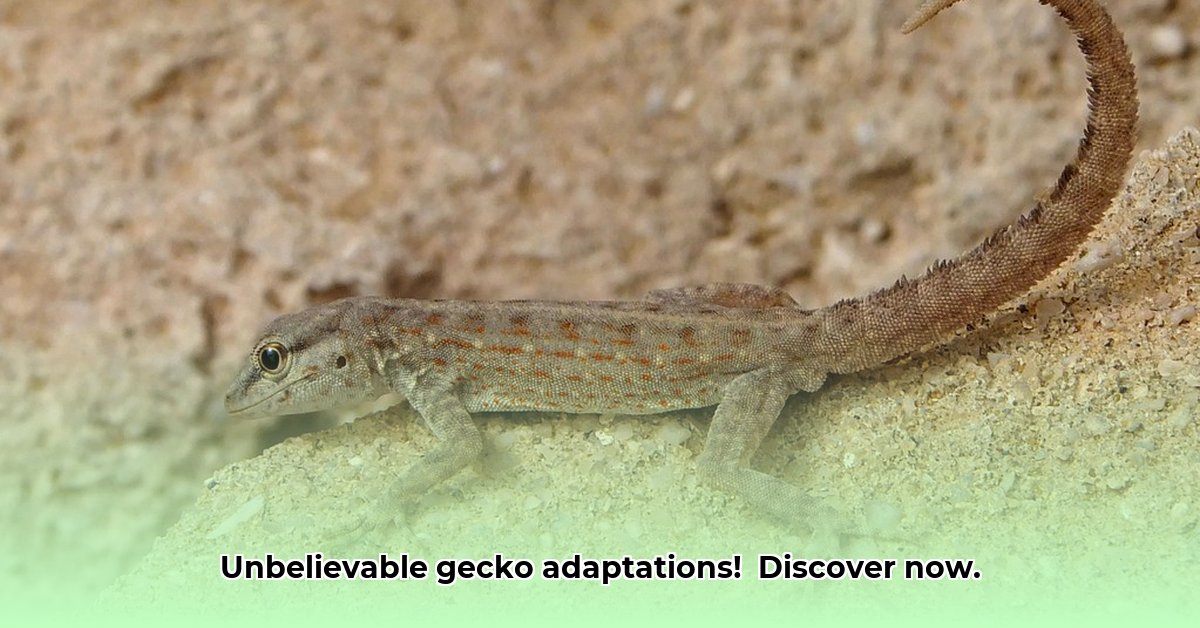
The Remarkable World of Geckos
Geckos, a diverse group of lizards, boast approximately 1,500 species inhabiting diverse global ecosystems. Their remarkable adaptability is evident in their wide range of sizes and appearances, from tiny desert dwellers to larger rainforest inhabitants. This astonishing diversity is a testament to millions of years of evolution, shaped by natural selection and environmental pressures. How did these reptiles achieve such widespread success and remarkable variation? The answer lies in their evolutionary superpowers.
Evolutionary Superpowers: Sight, Movement, and More
Geckos possess several remarkable adaptations enhancing their survival. Many species are crepuscular or nocturnal, utilizing specialized eyes. These eyes, equipped with enhanced light-sensitive cells and unique optical features, provide exceptional night vision. This "built-in night vision" allows them to thrive in low-light conditions. Their incredible climbing abilities are equally impressive. Microscopic hairs on their toe pads function as millions of tiny suction cups, enabling them to effortlessly scale walls and ceilings – a remarkable feat of adhesion. Furthermore, many gecko species exhibit caudal autotomy—the ability to shed their tail as a defensive mechanism against predators. The wiggling tail serves as a distraction, buying the gecko precious time to escape.
Gecko Reproduction: A Variety of Approaches
Gecko reproduction exhibits the same remarkable diversity as their physical adaptations. While most species reproduce sexually, the mechanisms involved are surprisingly varied. In some, the sex of offspring is determined by egg incubation temperature, a phenomenon called temperature-dependent sex determination (TSD). Other species display parthenogenesis (asexual reproduction), where females produce offspring without male involvement. This reproductive flexibility contributes to their adaptability and ability to colonize new habitats. The full extent to which these diverse reproductive strategies contribute to their ecological success is a subject of ongoing scientific investigation. Do these reproductive variations truly provide a competitive advantage? Further research is needed to answer definitively.
Challenges and Opportunities for Conservation
Despite their remarkable adaptations, many gecko species face significant threats. Habitat loss caused by deforestation, urbanization, and agricultural expansion is a primary concern. The destruction of their natural habitats diminishes their survival prospects. Furthermore, the lack of comprehensive population data for many species hinders effective conservation efforts. Uncertainty remains regarding the true extent of threats to different gecko populations.
Working Together to Save Geckos
Effective gecko conservation necessitates a collaborative effort involving scientists, conservation organizations, governmental agencies, and local communities. A multi-pronged strategy is crucial:
Enhanced Research: Further investigation is needed to fully understand gecko diversity and geographic distribution. Advanced genetic analyses will clarify evolutionary relationships and identify species at greatest risk.
Habitat Protection: Establishing and managing protected areas within critical gecko habitats is paramount. The preservation of their homes is crucial for their survival.
Community Engagement: Engaging and educating local communities is vital. Awareness programs highlighting the ecological importance of geckos can foster responsible environmental stewardship.
International Collaboration: Given the global distribution of geckos, international cooperation is essential. Sharing data and resources across borders maximizes the efficacy of conservation efforts.
The Future of Gecko Research and Conservation
Gecko research presents a unique opportunity to advance our understanding of evolutionary processes and ecological dynamics. Investigating their adaptations, reproductive strategies, and conservation challenges will inform broader biodiversity conservation strategies. The future of gecko conservation hinges on ongoing research, strengthened collaborations, and a collective commitment to habitat preservation. Ensuring the survival of these remarkable creatures requires an ongoing effort.
Stakeholder Involvement and Timeline
| Stakeholder | Short-Term Goals (0-1 year) | Long-Term Goals (3-5 years) |
|---|---|---|
| Scientists/Researchers | Comprehensive species surveys; refinement of evolutionary models | Development of advanced genetic tools; predictive habitat modeling |
| Conservation Groups | Threat assessment of gecko species; development of detailed conservation plans | Implementation of habitat restoration; establishment of protected areas |
| Zoologists/Museums | Digitization of collections; enhanced collaboration with researchers | Development of educational resources; advocacy for improved conservation policies |
| Government Agencies | Review and implementation of protective legislation | Creation of comprehensive biodiversity plans; effective enforcement of policies |
How to Effectively Conserve Threatened Gecko Species Based on Their Reproductive Strategies
Key Takeaways:
- Habitat loss is the foremost threat to geckos. Protection of their habitats is essential.
- The illegal pet trade significantly impacts gecko populations. Stricter regulations are necessary.
- Climate change exacerbates existing threats, necessitating immediate action.
- Understanding diverse gecko reproductive strategies is critical for effective conservation.
- Collaborative efforts among scientists, governments, communities, and the pet trade are vital.
The Amazing World of Gecko Reproduction and Conservation
The diverse reproductive strategies of geckos significantly influence conservation efforts. Understanding whether a species lays eggs or gives birth to live young, the number of offspring produced, and the environmental conditions needed for successful reproduction is crucial. This knowledge informs the development of targeted conservation strategies. For example, a species with a low reproductive rate requires a different approach than one with high fecundity.
Conservation Strategies Tailored to Reproductive Biology
Effective conservation of threatened gecko species necessitates a multifaceted approach tailored to their reproductive biology:
Habitat Protection: Preserving and restoring suitable habitats is fundamental. This entails mitigating threats like deforestation and urbanization, considering the specific habitat requirements of each species.
Captive Breeding Programs: For critically endangered species, captive breeding programs can be invaluable, but their success depends on detailed understanding of reproductive cycles and optimal breeding conditions.
Combatting the Pet Trade: Stricter regulations, enforcement, and public awareness campaigns are needed to curb unregulated harvesting and trade.
Climate Change Mitigation: Addressing climate change impacts, including adjustments in temperature, rainfall, and available habitats, is essential to the long-term survival of geckos.
Community Involvement: Collaborating with local communities leverages their valuable traditional ecological knowledge and fosters a sense of ownership in conservation efforts.
The Need for Integrated Approaches
Successful gecko conservation demands an integrated approach that recognizes the interconnectedness of factors impacting their survival: habitat, reproduction, illegal trade, and climate change. This holistic approach is key to safeguarding the future of these fascinating reptiles.